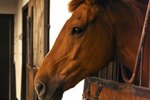Muscle wasting, or atrophy, in horses is a loss of muscle. It is a symptom that can be caused by damage to nerves or muscle fibers or a disease that causes weight loss. Some conditions that may cause muscle wasting include polysaccharide storage myopathy or equine protozoal myeloencephalitis.
Tips
If your horse starts to lose muscle mass, contact your veterinarian. Tests that help diagnose muscle wasting include muscle biopsy, electromyography and ultrasound. Your vet also will do blood work to check for abnormal enzyme and vitamin levels.
Equine Polysaccharide Storage Myopathy
Horses with equine polysaccharide storage myopathy fail to convert glycogen in the muscles. As a result, the muscles do not have the necessary fuel to function. The disease most often affects American quarter and paint horses and other stocky breeds. The cause of the disease is unknown, but may be genetic.
In addition to muscle wasting, equine polysaccharide storage myopathy causes muscle pain, twitching, an abnormal gait, stiffness, difficulty maintaining balance and heightened levels of creatine kinase and other enzymes.
Equine Protozoal Myeloencephalitis
Equine protozoal myeloencephalitis is caused by a parasite that affects the neurological system of horses. Horses contract the disease when they consume food or water contaminated with the parasite from opossum feces. Symptoms vary depending on what part of the neurological system the parasite infects and may include:
- Muscle atrophy
- Loss of coordination
- Poor balance
- Stiffness
- Abnormal sweating
- Difficulty swallowing
- Seizures
Equine Cushing's Disease
Cushing's disease occurs when a tumor affects the pituitary gland, causing it to release excess hormones. The disease more commonly affects ponies and horses older than 7. Symptoms include muscle wasting, fatty deposits in the neck, mouth ulcers, thickening of the coat, abnormal shedding and increased thirst and urination.
Writer Bio
Maureen Malone started writing in 2008. She writes articles for business promotion and informational articles on various websites. Malone has a Bachelor of Science in technical management with an emphasis in biology from DeVry University.




